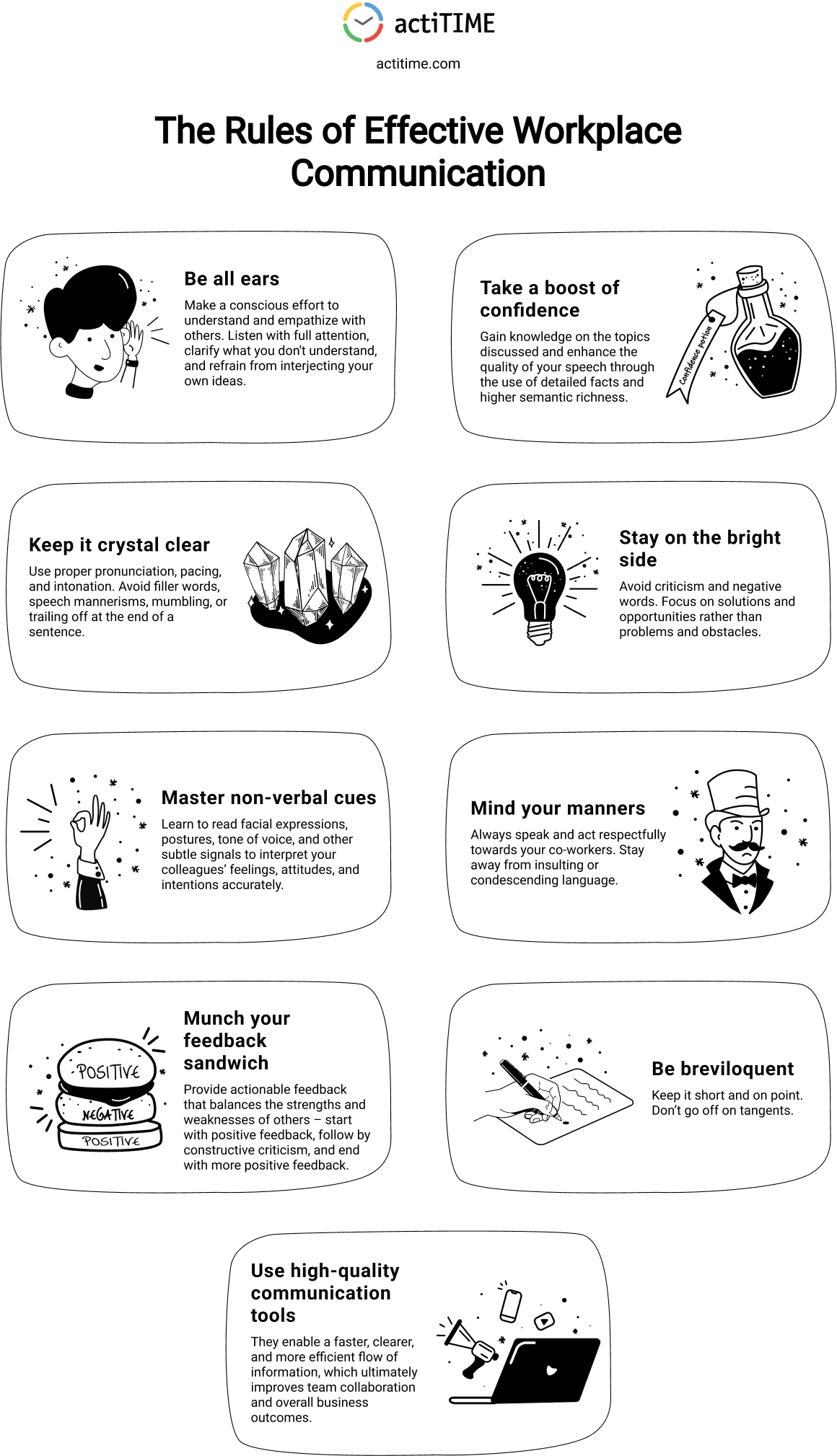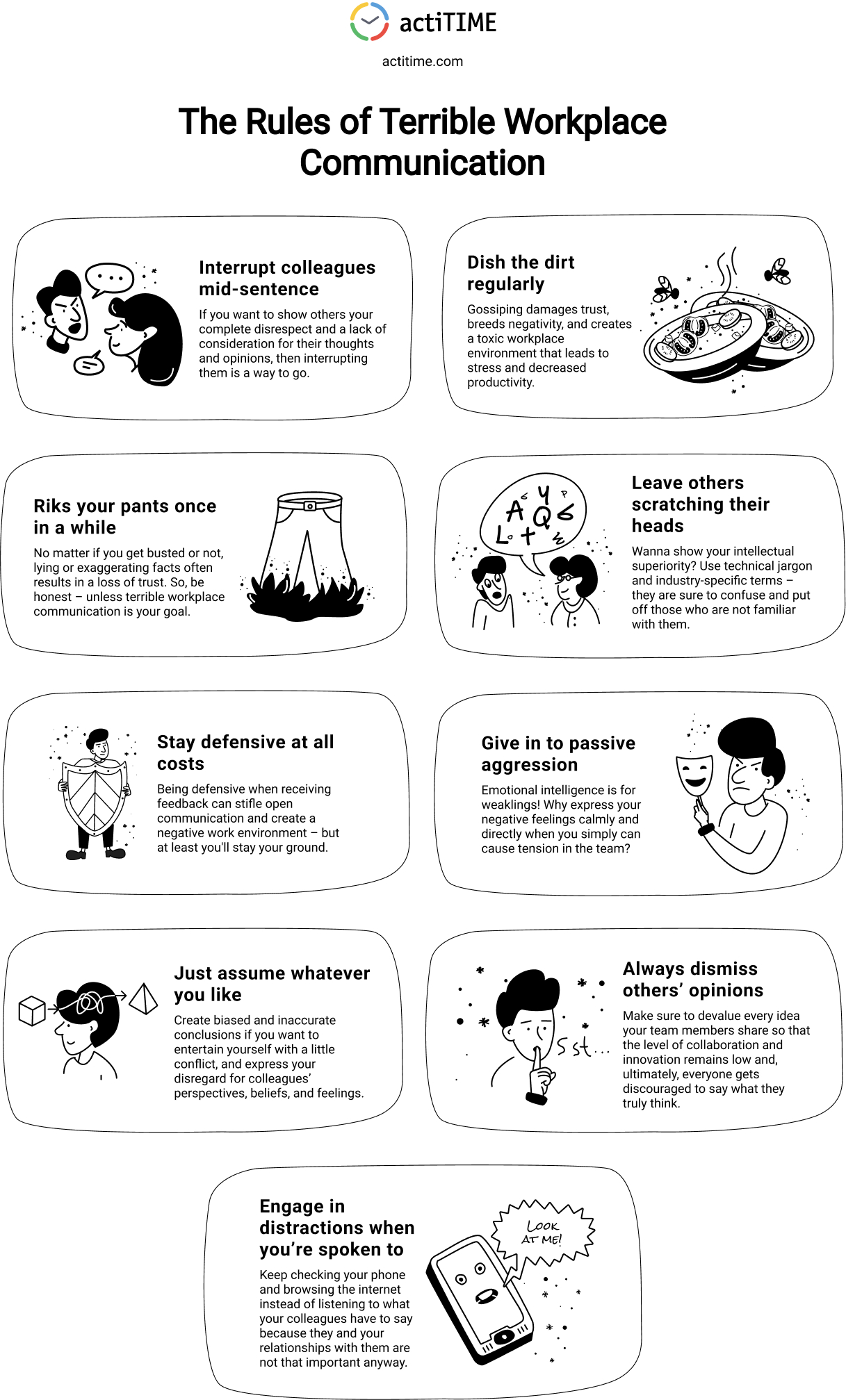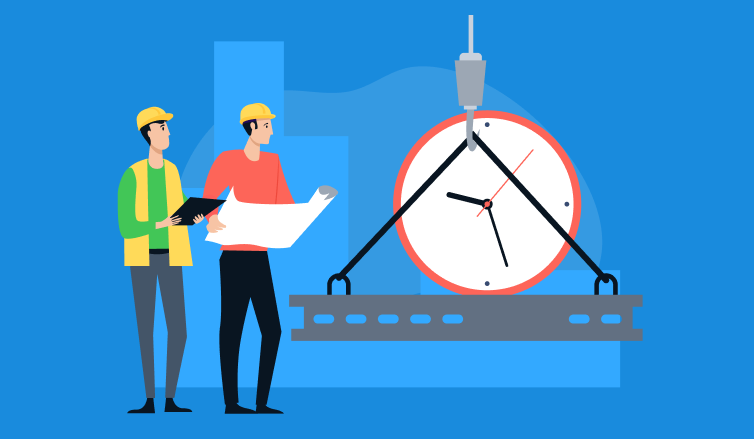
“Communication is a skill that you can learn.”
This phrase may have been drummed into us from an early age, but it doesn’t make the art of workplace communication that much easier.
Crafting focused messages, taking time to listen thoroughly, and politely addressing differences of opinion are the skills that managers and their team members alike need to have in order to be productive and work in harmony with each other.
So, to help you make sure everyone is on the same page and understand the fundamentals, we’ve created some handy infographics detailing the dos and don’ts of workplace communication.
Keep reading and find out how to never face miscommunication issues again!
Workplace Communication Infographic #1

5 More Handy Tips for Effective Workplace Communication
1. Promote collaboration
Collaboration can be a powerful engine that drives workplace success. By working together, employees can leverage each other’s strengths, share their expertise and knowledge, and pool their resources to achieve common goals. However, fostering collaboration is easier said than done.
Here are some practical tips to promote collaboration at your workplace:
- Embrace transparency. Employees must have access to the same information about a project’s goals, timelines, and resources. That way, they’ll have a shared understanding of what needs to be done and can work towards the same objectives.
- Create opportunities for cross-functional collaboration. Encourage employees from different departments to work together on projects. By doing so, employees gain skills that they can then share with others in the organization.
- Leverage collaboration tools. Providing employees with high-quality tools for project management or group messaging platforms can greatly enhance the ease of collaboration.
A great example of an efficiency-boosting team collaboration tool is actiTIME.
With its help, managers can easily assign tasks to team members, keeping them aligned with project requirements and timelines. It also includes features for progress monitoring that enable everyone on the team to track ongoing task performance in real time. This provides a great level of transparency, allowing you to identify gaps and make the necessary adjustments to improve productivity and efficiency.
Manage team workloads and track project progress using the Kanban board in actiTIME
Besides, actiTIME has insightful reports that assist in analyzing employee utilization, project profitability, and overall performance. They help to track key project metrics and make decisions that improve the performance of the team.
Learn how to use actiTIME as collaboration software here. 👈
2. Master conflict management
As much as we’d love to all get along like a bunch of carefree bumblebees buzzing about in perfect harmony, the reality is that conflict is an ever-present force in the workplace.
The problem is that conflicts can lead to a whole host of negative consequences, such as decreased morale, increased absenteeism, and higher turnover rates. But with well-developed conflict management skills, you are sure to keep it all at bay and gain the following benefits:
- Greater job satisfaction. When employees feel like their concerns are being heard and addressed, they’re more likely to feel valued and content in their positions. This can lead to increased productivity, as well as higher morale across the board. For employers, this means less turnover and a more stable workforce – no more scrambling to find a replacement for someone who’s had enough of office drama.
- Better relationships between coworkers. When issues are resolved in a constructive manner, it often results in a deeper understanding of others’ perspectives and a newfound respect for one another. This can lead to more effective collaboration and teamwork, which is crucial in many workplaces.
- Higher innovation and more creativity. When people feel comfortable sharing their ideas and concerns, there’s more opportunity for brainstorming and problem-solving. Plus, different viewpoints can often lead to unexpected solutions and approaches.
Find out how to resolve conflicts in project management here. 👈
3. Build strong interpersonal relationships
We spend a significant amount of our waking hours at work, so it’s only natural that we want to be surrounded by people we like and enjoy working with. However, it’s not just about socializing and having fun.
Studies have shown that employees with strong social connections at work are more engaged, more productive, and more likely to stay with their company long-term. In fact, a Gallup report revealed that employees who had a close friend at work were seven times more likely to be engaged in their jobs.
Furthermore, strong interpersonal relationships at work can lead to more effective collaboration and teamwork. When team members trust and respect one another, they tend to better communicate and work together towards common goals. This can lead to higher quality work, faster project completion, and better decision-making.
Improve employee relationships with these fun team-building activities. 👈
4. Be timely
Picture this: you’re waiting for important information from a colleague to finish your part of a project. You send a friendly reminder email but receive no response. Days pass, and your deadline is looming. You reach out again, but your colleague still doesn’t respond. Finally, you receive the information needed, but it’s too late – your deadline has passed, and the project is delayed.
As you can see, communication bottlenecks can have serious consequences, not just for individuals, but for entire organizations, causing missed opportunities, damaging reputation, and more.
This makes timely communication of paramount importance for any modern business. Not only does it ensure effective collaboration among team members but also enhances organizational efficiency by reducing turnaround times. Subsequently, it can help you save time and money while improving your company’s bottom line.
Find even more tips for effective workplace communication here. 👈
5. Don’t overload your team with meetings
Meetings, meetings, meetings…
If there’s one thing that can make or break a team’s productivity, it’s the dreaded meeting overload. It’s tempting to schedule all your team members for back-to-back meetings, but that’s not the way to get things done efficiently.
Here’s why:
- Meetings are time-consuming: They take up valuable chunks of your workday, and if you have too many of them, it can be difficult to find time for actual work. In fact, studies have shown that meetings can eat up as much as 35% of your workweek. That’s a lot of lost time!
- Meetings can be mentally taxing: Have you ever been in a meeting that dragged on and on, and by the time it was over, you felt like you needed a nap? That’s because meetings can easily drain your energy and focus. And that’s not the kind of productivity boost you’re looking for.
- Meetings can be counterproductive: If you’re constantly interrupting your team members’ workday with meetings, you’re disrupting their flow and momentum. This can make it difficult for them to stay on track and make progress on their projects.
Find our tips on running effective remote meetings here. 👈
Workplace Communication Infographic #2

Conclusion
Workplace communication has a direct and potentially lasting impact not only on the team’s morale but also on its overall success. But luckily, there are countless opportunities to embed effective communication into any team dynamic.
By following the dos and don’ts outlined throughout this article, you will definitely make your co-workers feel heard, inspired, and ready to take action. And remember – if you’re looking for an all-encompassing solution for streamlined work and team collaboration, look no further than actiTIME.
With this tool in hand, navigating project collaboration is sure to be an absolute breeze from here on out. So, sign up for a free trial now!

















































